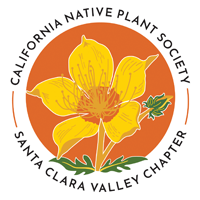Locally Native Trees to Plant at Your School or Home
By Jeff Caldwell
With the possible exception of the coast redwood and white alder, most of our locally native trees deserve to be cultivated more often in the San Francisco Bay area. Many are beautiful and easy to grow--they are well adapted to our climate and soils. Native trees offer special values for wildlife as well.
Big-leaf maple is a very attractive species, and also fast growing--it deserves a place in more landscapes.
The gray pine is a quite ornamental tree in cultivation and more drought tolerant and more resistant to air pollution than most pines.
Contrary to general opinion, the valley oak and coast live oak, two beautiful heritage species, grow fairly quickly and are easy to cultivate. While ancient trees which grew to maturity under summer dry conditions may resent irrigation, young oaks adapt to garden watering. Indeed, under garden conditions seedling oaks may reach 25 feet in ten years--they actually grow faster than many commonly planted trees! Our native oaks deserve to be planted far more often than they are; happily, they are becoming more popular.
The California nutmeg is an unusual conifer and not difficult to grow, though a bit slow. Its needles are extremely sharp, so it should not be planted near a path.
Our California laurel becomes a stately tree. It is slow growing, but well-situated specimens are a fine gift to future generations.
The coast redwood is met with often enough in cultivation locally, some say too often. It would be refreshing to see it mixed more often in man-made landscapes with its proven companions in the natural landscape, especially Douglas fir, tanbark oak and California laurel. Other possible redwood companions include big-leaf maple, white alder, coast live oak, interior live oak, California nutmeg, black cottonwood, and madrone.
Many people long to grow the madrone, one of the world's most beautiful broadleaf evergreen trees. It has not proven easy to cultivate, but if you like a gardening challenge, try this treasure!
Two of our native trees regarded as "ugly ducklings" deserve to be mentioned here especially for those who garden with wildlife in mind.
The California buckeye has lovely structure, interesting fruits, spectacular flowers, exquisite spring foliage--but a decided off-season as the deciduous leaves turn brown in the summer; it is the first to drop its leaves. Its flowers are despised by some because their pollen is somewhat toxic to the non-native honeybee, but no flowers have more value to butterflies. In bloom this tree may be festooned with butterflies; we have seen seven species nectaring on one tree simultaneously! The tiger swallowtail, mourning cloak, California sister, California tortoiseshell, spring azure and many others visit this tree. It is easy to grow.
The blue elderberry is considered too coarse and "common" by many gardeners, but the summer fruits attract a wider range of birds than any other tree. Songbirds favor it highly for food and nesting. It is easy to grow and very fast. A stump-sprouter, it is amenable to pruning, which may help keep it presentable.
Native Trees of San Mateo and Santa Clara Counties
| Aceraceae (Maple Family) | |
|---|---|
| Acer macrophyllum | big-leaf maple |
| Acer negundo var. californicum | box elder |
| Betulaceae (Birch Family) | |
| Alnus rhombifolia | white alder |
| Caprifoliaceae (Honeysuckle Family) | |
| Sambucus mexicana | blue elderberry |
| Ericaceae (Heath Family) | |
| Arbutus menziesii | Pacific madrone |
| Fagaceae (Oak Family) | |
| Lithocarpus densiflorus | tanbark oak |
| Quercus agrifolia | coast live oak |
| Quercus chrysolepis | canyon live oak |
| Quercus douglasii | blue oak |
| Quercus garryana | Oregon white oak |
| Quercus kelloggii | California black oak |
| Quercus lobata | valley oak |
| Quercus wislizeni | interior live oak |
| Hippocastanaceae (Buckeye Family) | |
| Aesculus californica | California buckeye |
| Lauraceae (Laurel Family) | |
| Umbellularia californica | California laurel |
| Oleaceae (Olive Family) | |
| Fraxinus dipetala | flowering ash |
| Fraxinus latifolia | Oregon ash |
| Pinaceae (Pine Family) | |
| Pinus attenuata | knobcone pine |
| Pinus ponderosa | Pacific ponderosa pine |
| Pinus sabiniana | gray pine |
| Pseudotsuga menziesii | Douglas fir |
| Platanaceae (Sycamore Family) | |
| Platanus racemosa | Western sycamore |
| Salicaceae (Willow Family) | |
| Populus fremontii ssp. fremontii | Fremont cottonwood |
| Populus balsamifera ssp. trichocarpa | black cottonwood |
| Salix laevigata | red willow |
| Salix lasiolepis | arroyo willow |
| Salix lucida ssp. lasiandra | shining willow |
| Taxaceae (Yew Family) | |
| Torreya californica | California nutmeg |
| Taxodiaceae (Bald Cypress Family) | |
| Sequoia sempervirens | redwood |
References:
Ferris, Roxana S. 1968. Native Shrubs of the San Francisco Bay Region. University of California Press.
Hickman, James C. (ed.). 1993. The Jepson Manual Higher Plants of California. University of California Press.
Metcalf, Woodbridge. 1959. Native Trees of the San Francisco Bay Region. University of California Press.
Sharsmith, Helen K. 1982. Flora of the Mount Hamilton Range of California. California Native Plant Society.
Thomas, John Hunter. 1961. Flora of the Santa Cruz Mountains of California. Stanford University Press.
Prepared by Jeff Caldwell (revised 2/98)

